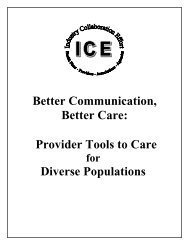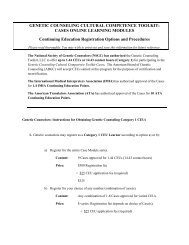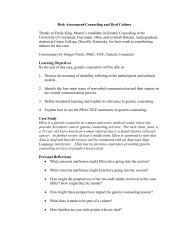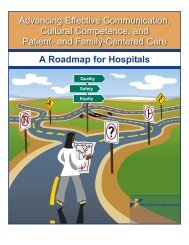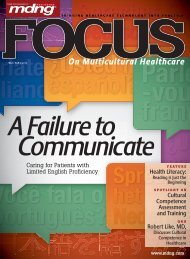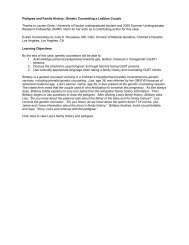making the business case for culturally and linguistically appropriate ...
making the business case for culturally and linguistically appropriate ...
making the business case for culturally and linguistically appropriate ...
Create successful ePaper yourself
Turn your PDF publications into a flip-book with our unique Google optimized e-Paper software.
APPENDIX FMultilingual Health ResourceExchange ProjectUCare MinnesotaCLAS St<strong>and</strong>ards Met: 1, 4, 5, 7, <strong>and</strong> 12See page 12 <strong>for</strong> list of CLAS St<strong>and</strong>ardsISSUE. According to a 2003 Minnesota Legislative report, disparities in health statusbetween <strong>the</strong> majority population <strong>and</strong> populations of color <strong>and</strong> American Indians are, in some<strong>case</strong>s, getting worse. In addition, with 124 languages now spoken in Minnesota (some of <strong>the</strong>most common being Hmong, Russian, Somali, Spanish <strong>and</strong> Vietnamese) UCare saw a greatneed to collaborate with o<strong>the</strong>r partners to address <strong>the</strong>se health disparities <strong>and</strong> overcomelanguage barriers to health care. The production <strong>and</strong> distribution of health materials <strong>for</strong>Limited English Proficient (LEP) patients can be a significant expense <strong>and</strong> logisticalchallenge <strong>for</strong> any one health care organization to undertake. UCare invests time <strong>and</strong>resources to partner with communities to address <strong>the</strong>ir cultural <strong>and</strong> linguistic needs, which isessential to improving <strong>the</strong>ir health status. Empowering LEP members is facilitated throughcollaboratives such as <strong>the</strong> Multilingual Health Resource Exchange because <strong>the</strong>y increase <strong>the</strong>number of <strong>culturally</strong> <strong>and</strong> <strong>linguistically</strong> <strong>appropriate</strong> resources available to <strong>the</strong> members <strong>and</strong>,<strong>the</strong>reby, enhance <strong>the</strong> members' ability to underst<strong>and</strong> <strong>and</strong> act on <strong>the</strong> in<strong>for</strong>mation <strong>the</strong>y need tostay healthy <strong>and</strong> to receive care when ill.DISCUSSION. In carrying out it’s mission “to improve <strong>the</strong> health of members throughinnovative services <strong>and</strong> partnerships across communities”, UCare noted that LEP patientsdeserve more underst<strong>and</strong>able in<strong>for</strong>mation about <strong>the</strong>ir health <strong>and</strong> <strong>the</strong>ir providers needed bettertools to deliver health <strong>and</strong> social services that are specific to <strong>the</strong>ir patients’ cultures.Providing multilingual health resources in a user-friendly, central database is one way toaddress this need. As a way to accomplish this, UCare partnered with some o<strong>the</strong>r healthplans, hospitals, clinic groups, public health organizations, <strong>and</strong> o<strong>the</strong>r groups tocollaboratively establish <strong>the</strong> Multilingual Health Resource Exchange, a web-basedclearinghouse <strong>for</strong> health consumer materials specifically developed <strong>for</strong> Limited EnglishProficient (LEP) patients.The project began in 2001, with a sharing of health education materials among more than adozen o<strong>the</strong>r Minnesota health care organizations. In 2002-2003 <strong>the</strong> ef<strong>for</strong>ts led to <strong>the</strong> creationof an internet database of multilingual health resources. The goals of <strong>the</strong> Multilingual HealthResource Exchange (Exchange) include:• Sharing in<strong>for</strong>mation about all available translated materials;• Exchange of translated written, audio <strong>and</strong> video health education resources throughan online database;• Collection of additional resource in<strong>for</strong>mation about health education approaches thatwork <strong>for</strong> patients whose primary language is not English; <strong>and</strong>• Conduct a gap analysis of materials to determine what new materials need to bedeveloped in particular languages.42



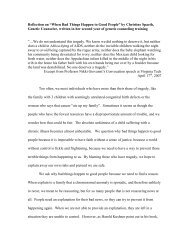
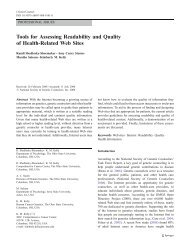

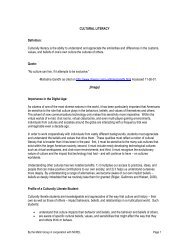
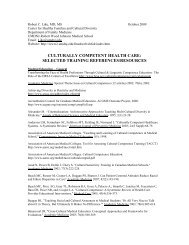

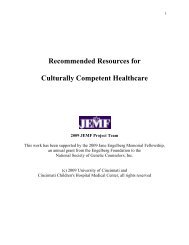
![Breaking Bad News PPT[1] - Genetic Counseling Cultural ...](https://img.yumpu.com/35003134/1/190x146/breaking-bad-news-ppt1-genetic-counseling-cultural-.jpg?quality=85)
